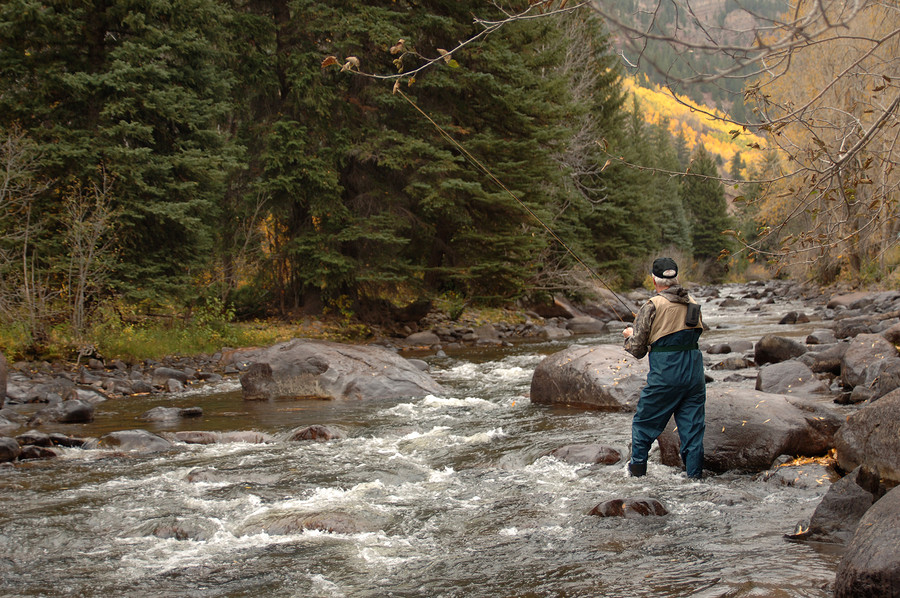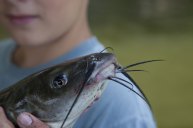When I first got into fly fishing, it was information overload. Trying to learn about tippets, leaders, fly line, backing, weight, nymphs, streamers... You could go down this rabbit hole forever and still not have mastered it. While understanding these terms become crucial to being an avid fly angler, taking baby steps and learning as you go is without a doubt the most appropriate method.
I personally believe that one of the first things that any beginner fly fisherman should learn is fly rod weights. You've likely heard about this, and maybe have seen the writing on the base of your fly rod. Maybe it says something like 8WT or maybe even 5WT 8'6". If this all looks Greek to you, don't worry. It's pretty simple once you understand the basics.
What the Numbers Mean

JMichl/Getty
The numbers listed on a fly rod will generally tell you the weight (or "WT") of the rod is, and that corresponds to which fly line weight should be used with it. Fly rods are also often labeled with the length as well as the number of pieces it breaks down to.
For example, if you see a fly rod that says 7WT 9' 4pc, that means that rod is a 7 weight and thus should be used with a 7 weight line; it is 9 feet long, which is a very common length; and it breaks down into 4 pieces.
Fly rod weights can range from 2-14, and the higher you go, the heavier the line. That also means the size of the fly can be bigger, and you can go after bigger fish. The smaller you go, the lighter the line, smaller the fly, and smaller fish you'll go after.
Fly rod lengths can vary from 7 feet to as much as 14 feet or more. Generally, you'll see people using 8'6" to 9' rods. These lengths are ideal for most freshwater and saltwater fishing applications. Most rods will break down into 3 or 4 pieces.
Now that you know what the numbers mean, we'll help you determine which weight is the best for you and your fishing.
What You Should Use

What fly fishing rod weight you use will depend on what kind of fish you are going after and where you will be fishing. As you become more advanced in your fly fishing, you may want to have a universal set up of multiple fly rods that you can use for several different occasions. For example, in my setup I have a 5WT, a 7WT, and a 9WT, which will essentially cover me for any sort of fishing that I could experience in North America.
But if you're just starting out, it's likely that you won't want to break the bank and probably just limit yourself to one fly rod. So the question still remains, which is best? I'll break down each weight group and explain how they are commonly used, and you can make your decision based on their functions.
2-4 Weight
A 2-4 weight fly rod doesn't have much versatility, although they can provide some of the most fun you'll ever have with a fly rod. The fight a little panfish can give feels extra tough on a rod of this type. Ideally these are used on small and narrow streams catching smaller species like sunfish and crappie. I have had luck with them in the West Virginia mountains catching small stream brook trout, too. These rods should be reserved for narrow bodies of water where the furthest you would be looking to cast is about 20 feet.
5-6 Weight
A rod in the 5-6 weight range is what I would recommend for all first time fly anglers. They are the most universal weights and can be suitable to catch anything from brown trout out west to striped bass on the eastern side of the country. While they don't quite allow you to cast as far as a 7 or 8 weight will, they still let you reach out and execute a soft fly landing, which is especially crucial for trout fishing. These also make great beginner rods because of their ease of use and middle ground, plus they're great for largemouth bass fishing, America's favorite warm water species. I first learned how to cast on a 6 weight and it was exactly what I needed to nail the basics.
7-8 Weight
A 7-8 weight rod is another amazing and versatile rod that you can use on freshwater, but it's also great for an experiment with saltwater. Your long casts won't include as delicate presentations as they would with lighter weights, but you'll be able to tie on some big streamers and catch muskie or pike if wanted. You should have no problem casting a 7-8 weight well over 60 feet, which can really come in handy depending on where you are fishing. As far as versatility goes, this range is second only to the 5-6 weight category. I have even seen people target big fish like steelhead with an 8 weight, so your options aren't nearly as limited as the ones mentioned before.
9 Weight
I wanted to leave the 9 weight by itself because it really is in a very specific class of its own. You'll be able to target steelhead and salmon while also being comfortable on several saltwater species. With this weight you'll be able to cut through wind with your casts and have adequate line strength to haul in feisty, larger fish like bonefish and permit in the saltwater flats. This is a must have for most saltwater fly anglers.
10+ Weight
This level is almost entirely targeted towards saltwater anglers. People who are going after massive tarpon and heavy amberjacks require a 10 weight. These are going to be used with heavy streamers and be able to withstand 30-plus-minute battles with these hefty fish.
I would highly advise any new angler that is just getting started fly fishing to perhaps put a 10 weight on the backburner for now, and focus more on being set up for targeting the fish you're likely to catch. Saltwater fly fishing trips can be a blast, but can be extremely difficult and harder to come by, especially if you live far from the coast. More often than not, saltwater fish species are extremely wary and a perfectly casted fly is crucial to getting a bite.
Start with the basics, and once you have that down, take a consideration for the other fly rod weights that might apply to your style.




